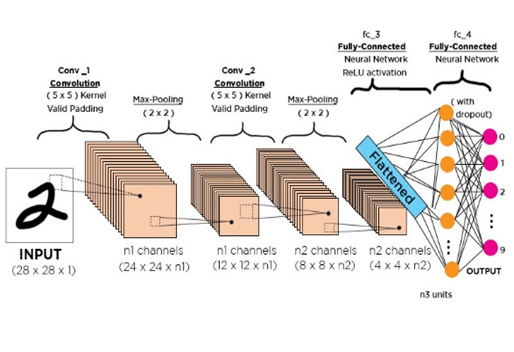
An overview of GDPR complying EU laws in writing a research proposal for human protection
October 29, 2020
An overview of fixed effects assumptions for meta-analysis
November 5, 2020In-Brief
Deep Learning is an inevitable branch of Artificial Intelligence technology. In which, Convolutional Neural Network is a modern approach to visualize the images with high performance. These networks help for high performance in the recognition and categorization of images. It has found applications in the modern science sectors such as Healthcare, Bioinformatics, Pharmaceuticals, etc. for Meta-analysis Writing Services
Introduction
The growth of massive datasets creates a need for more advanced tools for analysis. CNN is such a tool that is mainly for analyzing the images. Currently, in healthcare and clinical management, it is used for diabetic retinopathy screening, skin lesion classification, and lymph node metastasis detection for meta-analysis research. Radiology is a scientific front used in the healthcare sector for diagnosing various types of diseases via different imaging techniques like ultrasound, X-ray radiography, MRI. Therefore, CNN and Radiology find a mutual relationship in meta-analysis paper writing
Convolutional Neural Network (CNN)
Convolution Neural Network is also known as Convents. CNN is an in-depth learning approach that was inspired by the animal visual cortex. The design is to adapt and learn low to high-level patterns. In this, there are specific terms used, each defining certain things – (i) Parameter: A variable that is automatically learning process with the meta-analysis experts (ii) Hyperparameter: A variable that needs to be performed before training (iii) Kernel: A set of learnable parameters.
Architecture of CNN
Writing a meta-analysis paper about the network comprises three blocks – Convolution, pooling, connected blocks. The initial two layers perform feature extraction, and the final one produces the output. A typical convolution layer contains a stack of these layers in a repeated order.
Convolution layer is the fundamental layer of CNN that consists of a combination of linear and nonlinear operations. The main feature of convolution operation is weight sharing. The output of the convolution layer passes through the nonlinear activation function.
Pooling layers reduce the dimensionality and combine the outputs of the previous layers into a single neuron present in the next layer. Max pooling is the popular pooling operation which utilizes maximum neuron clusters.
Connected layers connect all neurons in a line. It works by abiding the principle of Multi-Layer Perceptron. Every fully connected layer follows a nonlinear function.
Applications in Radiology
While analyzing the medical images, classification takes place by targeting the lesions and tumours. Other categories of those are into two or more classes. Many training data is there for better type using CNN.
After the classification process, the segmentation process takes place. Segmentation of organs is the crucial role in image processing techniques. Segmentation is a time-consuming process. Instead of manual segmentation, CNN can be applied for segmenting the organs. To train the network for the segmentation process, medical images of the organs and those segmentation results are used.
CNN classifier is used for segmentation to calculate the probability of finding the organs. In this, firstly, a probability map of the organs using CNN is done, later, global context of images and other probability maps by conducting a meta-analysis.
After all these, the abnormalities within the medical images must be detected. Those abnormalities may be existing or may not be in typical cases. In previous studies, 2D-CNN is used for detecting TB on chest radiographs. For develop the detection system and evaluate its performance, the dataset of 1007 chest radiographs performs well.
About 40 million mammography examinations are done every year in the USA. Those were made mainly to screen programs aiming to detect breast cancer at early stages by the meta-analysis in quantitative studies
Advantages of CNN
Currently, specific techniques like texture analysis, conventional machine learning classifiers like random forests and support vector machines are useful. Howbeit, CNN posses its advantages. It does not need hand-made feature extraction. Then, the architecture of CNN does not require segmentation of parts like differentiating tumors and organs.

Future Aspects
There are several methods to facilitate deep learning. But, well-annotated medical datasets in huge size are required to accomplish the perspectives of deep understanding. This kind of dedicated pre-trained networks can be used to foster the advancement of medical diagnosis. The vulnerability of deep neural networks in medical imaging is crucial since the clinical application requires robustness for eventual applications compared to other non-medical systems.
Deduction
More datasets are produced in both medical and non-medical fields. It has become obvious to apply more deep learning to ease analyzing and recognizing them. CNN’s and other deep learning techniques are helpful in healthcare and health risk management guided by the help of Pubrica and giving Meta-analysis Writing Services
References
- Banerjee, I., Ling, Y., Chen, M. C., Hasan, S. A., Langlotz, C. P., Moradzadeh, N., …&Farri, O. (2019). Comparative effectiveness of convolutional neural network (CNN) and recurrent neural network (RNN) architectures for radiology text report classification. Artificial intelligence in medicine, 97, 79-88.
- Lee, Y. H. (2018). Efficiency improvement in a busy radiology practice: determination of musculoskeletal magnetic resonance imaging protocol using deep-learning convolutional neural networks. Journal of digital imaging, 31(5), 604-610.
- Yamashita, R., Nishio, M., Do, R. K. G., &Togashi, K. (2018). Convolutional neural networks: an overview and application in radiology. Insights into Imaging, 9(4), 611-629.
